

By Jove! This year a special planetary alignment will occur on December 21st, also the Winter Solstice, when earth’s northern pole is at its greatest tilt away from the Sun. During this “Longest Night,” the planets Saturn and Jupiter will be within a tenth of a degree to one another, appearing to form a single “star.”
While an alignment of Saturn and Jupiter happens about every 20 years, when it happens in 2020 it will be one of the closest alignments of these two planets for over 800 years, and by some accounts since the year 1226.[1] The 1226 Saturn-Jupiter conjunction coincided with several historical milestones. In France, the reign of Louis IX, the only French king to be canonized by the Catholic Church, began following the death of his father Louis VIII. In Norway, the cleric Brother Robert translated the popular chivalric romance of Tristan and Iseult into Old Norse at the request of King Haakon IV. In the Kingdom of Georgia, the Sultan Jalal ad-Din Mingburnu, last ruler of the Khwarezmian Empire, captured Tbilisi in the Battle of Garni. The mendicant friar, preacher, and later saint Francis of Assisi died on October 3rd. And according to Canadian astronomer and historian Vibert Douglas, the Mongol emperor Genghis Khan abruptly ended his military campaign in China, possibly owing to the phenomenon of five separate planetary conjunctions over the years 1226 and 1227.[2]
In the Middle Ages, the seven “planets”—Saturn, Jupiter, Mars, Venus, Mercury, and the sun and moon—were important celestial bodies in the heavenly realm. Each was thought to have a distinctive personality, an idea still reflected in Gustav Holst’s orchestral suite The Planets, composed between 1914 and 1916. Holst calls Jupiter “The Bringer of Jollity” and Saturn—colloquially also known as “Father Time”—“The Bringer of Old Age.” These names doubtless influenced the artistic expression in the series of dance performances for Holst’s Planets by the Princeton University Ballet in 2018 linked above.

Jupiter, the largest planet in the solar system, was initially named after the ancient Roman god of thunder, and its planetary neighbor Saturn, the god of agriculture and harvest, was also Jupiter’s father. In Greek mythology they are Zeus and Cronus and were sometimes represented by medieval artists as luminous pointed stars, or solid spheres in concentric circles of earth-centered astronomical diagrams, as in this later copy of a Byzantine geocentric model of the cosmos (Fig. 1).
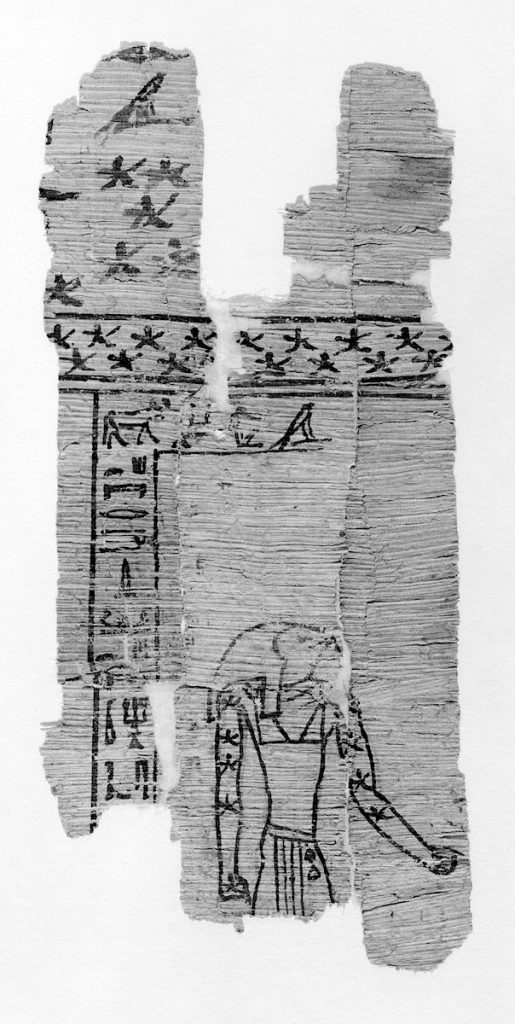
Representations of the planets are found in the artistic traditions of many cultures in which astronomy was an important science, including the Mesopotamian, Egyptian, Hellenistic, Indian, Byzantine, Islamic, and Chinese spheres. A possible early figuration of the planet Saturn can be seen on this ancient papyrus fragment in the Metropolitan Museum of Art as an Egyptian deity (Fig. 2). A much later figuration of the planets is found in this sixteenth century “Book of Felicity” (Matali’ al-saadet) made for Sultan Murad III (r. 1574–1595), now in the Bibliothèque nationale de France, which contains images of the “exaltation” and “dejection” of the planets—that is, when they are in apogee and perigee (Fig. 3). On folio 33v, Saturn’s exaltation in Libra is represented by the zodiacal scales, and his dejection in Aries shows him falling headfirst onto the back of a ram. The lower two vignettes similarly depict Jupiter’s exaltation in Cancer by pairing him with the zodiacal crab, and his dejection in Capricorn by tumbling onto a goat.[3]
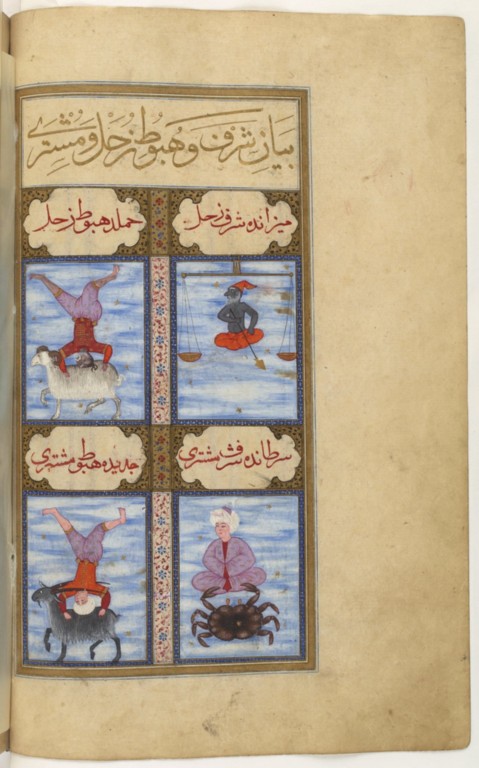
In western European art, the planets were presented both as heavenly bodies and in symbolic form. In this late medieval manuscript of the Confessio Amantis (“The Lover’s Confession”) by John Gower, a small miniature of the planetary system, prefacing the part on Astronomy, contains the sun and moon with human faces among five gold and starry planets, the uppermost two labeled with their Latin names “Saturnus” and “Iubiter” (Fig. 4).

In Dante’s Divina Commedia, the spheres of heaven were represented by planets; Saturn was the seventh sphere and Jupiter the sixth. In this illustration of Paradiso 22, the scene of the “Heaven of Saturn” is portrayed by Beatrice and Dante welcoming five nude souls descending a ladder from a glowing red star with seven points (Fig. 5). Reading the Paradiso, we know that this level of heaven was reserved for the contemplanti, or the founders of monastic orders, “men who were kindled by that heat which brings to birth the blessed flowers and blessed fruits.”[4]

In other medieval works the planets of the cosmos (and sometimes their children!) were personified as human figures.[5] In some of the earliest examples, planets were depicted as crowned figures, triumphant generals, or wearing laurels, rayed headpieces or wings; such types appear on Roman coins and as bust-length personifications in illustrated poems known as carmina figurata.[6]
Some representations evoked the temperaments often associated with each planet. Associated with the ambivalent nature of melancholy, Saturn was often configured as an old man with a handheld sickle (or a more “modern” scythe) and with a cloak draped over his head, but he can also hold a shovel, a wheel, and small nude figure, which he raises up as if to devour, a reference to the Greek myth in which he swallowed his children.[7] Jupiter was seen as a protective deity: his iconography varies from the classical, bearded archetype of “Zeus Pater” (Zeus the Father), who brandishes lightning bolts, a celestial wheel, or other symbols of his power, to his personification as a bishop in a late fifteenth-century astronomical miscellany in the Getty Museum.[8]
In classical mythology it was held that Jupiter drove Saturn away from his celestial throne. A marginal scene in this ninth century Homilies of Gregory Nazianzen depicts this dramatic argument of the ancients (Fig. 6). Saturn is pursued by Jupiter both wielding an axe, illustrating the First Invective against Julian the Emperor, “… let Jove rebel against Saturn, following his sire’s example; that sweet stone and bitter slayer of tyrants …”[9] In an early eleventh century manuscript of Rabanus Maurus’s encyclopedic De Universo, one miniature depicts Saturn with a scythe, nearly as tall as he, and Jupiter holds a symbolic pair of attributes: an eagle for deified justice and a serpent representing the age-old struggle for it (Fig. 7).
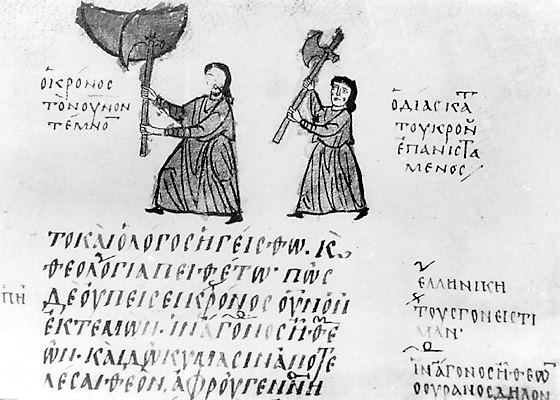
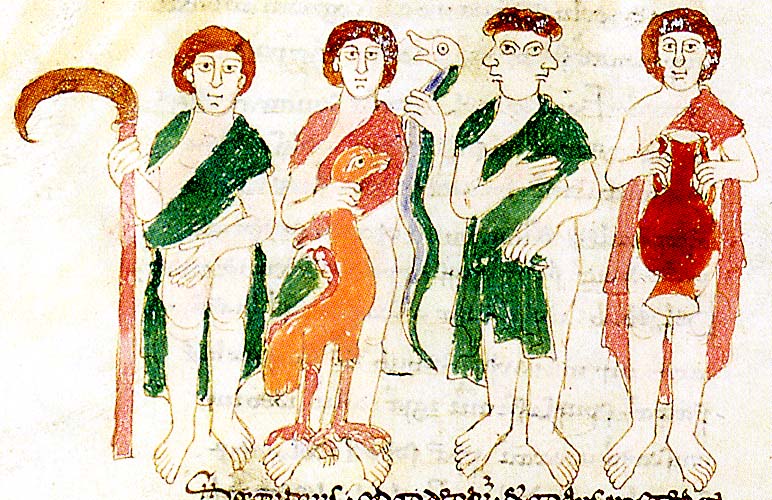
Two highly emblematic representations of the planets Jupiter and Saturn appear in the Rheinish manuscript of the Von Dem Gang des Himmels und Sternen (“The Course of the Heavens and Stars”), forming its own “planetary conjunction” at the close of the book (the miniatures are on facing pages). Both planets, Saturn personified as a simple farmer and Jupiter as city patrician, are decorated with imagery from a number of astrological and zodiacal sources, including their corresponding symbols for Libra and Cancer (Figs. 8 & 9).

The Index of Medieval Art database includes much more in the way of celestial imagery, including subjects related to the iconography of the other planets, stars, zodiac symbols, and constellations. The database also can be keyword searched for other named astronomical objects, such as “Star of Bethlehem.” These examples appear in a wide variety of works of art, including almanacs, calendars, astrological treatises, constellation maps, zodiac cycles, and a variety of narrative and allegorical works, and across different media, cultures, and periods.
The planetary motions of Saturn and Jupiter have been described by astronomers, such as Newton, Kepler, and Laplace, as “The Great Inequality,” meaning that while Jupiter’s mean period of motion is continually increasing, Saturn’s is continually diminishing and falling further behind.[10] Thus, both planets have long been approaching each other in the same direction, yet with enormous discordance.
The year 2020 has had its own prelude of tumultuous moments leading up to this great planetary conjunction. As the globe still grapples with a challenging year, it’s easy to imagine this alignment of Saturn and Jupiter as a sort of “clash of the titans,” but when we look west in the sky just after sunset, let us recall that this special occurrence, a most rare ballet of the planets, also marks a new season that will bring more light to our days.
[1] O’Neill, Mike. “Don’t Miss It: Jupiter, Saturn Will Look Like Double Planet for First Time Since Middle Ages.” SciTechDaily, 23 Nov. 2020, https://scitechdaily.com/dont-miss-it-jupiter-saturn-will-look-like-double-planet-for-first-time-since-middle-ages/; Strickland, Ashley. “Jupiter and Saturn Will Look like a Double Planet Later This Month.” CNN, Cable News Network, 3 Dec. 2020, https://www.cnn.com/2020/12/03/world/jupiter-saturn-conjunction-2020-scn-trnd/index.html; Levenson, Michael. “Jupiter and Saturn Head for Closest Visible Alignment in 800 Years.” The New York Times, The New York Times, 6 Dec. 2020, https://www.nytimes.com/2020/12/06/science/space/jupiter-saturn-align-christmas-star.html.
[2] Douglas, A. Vibert, “Historical Significance of Five Conjunctions, 1226–27,” Journal of the Royal Astronomical Society of Canada 65 (1971): 129–132.
[3] See also this exquisite engraved and inlaid brass tray with personifications of planets made by Mamluk craftsmen and commissioned by a Sultan in Yemen in the early fourteenth century (Metropolitan Museum of Art, 91.1.60). For more on astronomy and astrology in the medieval Islamic world, see this essay by Marika Sardar: https://www.metmuseum.org/toah/hd/astr/hd_astr.htm.
[4] Paradiso 22, 47–48 accessed at Barolini, Teodolinda. “Paradiso 22: Controlled Orphism.” Commento Baroliniano, Digital Dante. New York, NY: Columbia University Libraries, 2014. https://digitaldante.columbia.edu/dante/divine-comedy/paradiso/paradiso-22/. See also the Princeton Dante Project https://dante.princeton.edu/pdp/, with recent news and developments on the project here, https://humanities.princeton.edu/2020/11/29/2020-rapid-response-grant-literary-visualizations-reconstructs-imaginations-of-dantes-readers/.
[5] Discussion of the planets and their characteristics, temperaments, and affinities are found in many almanacs, planet books, and other cosmological treatises. See especially the classic Warburgian study by Raymond Klibansky, Erwin Panofsky, and Fritz Saxl, Saturn and Melancholy: Studies in the History of Natural Philosophy, Religion, and Art (London: Nelson, 1964). Reissued by McGill-Queen’s University Press, 2019.
[6] The Index database records three examples of planetary carmen figuratem, all in the British Library, MS. Cott.Tib.B.V (fol. 44v), MS. Cott.Tib.C.I (fol. 33r), and MS. Harley 647 (fol. 13v).
[7] Klibanksy, Panofsky, and Saxl, Saturn and Melancholy, 197.
[8] For the Jupiter-Bishop on horseback see Getty Museum, MS. Ludwig XII 8 (83.MO.137), fol. 49v. See also the Art Stories post by Bryan C. Keene, “Written in the Stars: Astronomy and Astrology in Medieval Manuscripts,” Getty Iris Blog (30 April 2019), https://blogs.getty.edu/iris/written-in-the-stars-astronomy-and-astrology-in-medieval-manuscripts/.
[9] See lines 120–121: Gregory Nazianzen, “Julian the Emperor” (1888). Oration 4: First Invective Against Julian. The Tertullian Project, 14 Dec. 2020, http://www.tertullian.org/fathers/gregory_nazianzen_2_oration4.htm.
[10] Wilson, Curtis, “The Great Inequality of Jupiter and Saturn: From Kepler to Laplace,” Archive for History of Exact Sciences 33, no. 1/3 (1985): 15–290.
While the other months of the year had specific harvesting tasks associated with them, the relative ease of May was a welcome relief from the daily toil that dominated medieval life. May occupations are traditionally represented as more joyous, particularly in Books of Hours and Psalters. The Index database records over 180 scenes for May in manuscripts, and a little over half of them use the occupation of the male falconer on horseback (see related subjects: Month, Occupation: May; Figure, Male: Falconer; Horseman: Falconer; and Scene, Sports and Games: Falconer). Falconry, or Hawking, was a favorite medieval sport enjoyed especially at the beginning of spring. These hunting birds were prized for their agility and loyalty to their masters. Another popular scene depicting May is a pair of lovers on horseback, occasionally with a bird perching on the man’s wrist. This scene of a riding couple was a favored occupation and signaled the readiness for new courtships. Other instances of May scenes include figures holding flowers or wreaths, couples promenading, and other verdant scenes of courtship, whether amid blooms in grassy gardens or even on boats (see related subject: Scene, Secular: Courting).

The zodiac sign that commences in May is Gemini, traditionally represented by a pair of figures—Gemini being Latin for “twins”—that are linked to their astrological appearance in the sky (see related subjects: Zodiac Sign: Gemini and Constellation: Gemini). The representations of Gemini can also be divided into a few main categories. A sample of about 80 French medieval manuscripts reveals that the most popular Gemini sign was the embracing nude couple, with far fewer of them appearing clothed. Often the couple’s bodies are masked by parts of the landscape or are cropped by a frame. Nude twins are the second most common Gemini sign and are usually depicted as two men embracing or wrestling. Sometimes the twins will appear as confronted soldiers with mirrored weapons and gear. The twin variations in Gemini also include pairs with crossed legs, conjoined bodies, or even one figure with two heads.

The subjects for months and zodiac signs are most prevalent in manuscripts, but they are also well-represented in sculpture such as the famous façades at Chartres and Vézelay. In 2007, information on all zodiac and occupation subjects classified by the Index was collected and published with Penn State University Press as Time in the Medieval World: Occupations of the Months and Signs of the Zodiac in the Index of Christian Art. This book has been hailed as a “lavishly illustrated” and “functional research tool” for studying the subject of the medieval measuring of time.
Hourihane, C., ed. Time in the Medieval World: Occupations of the Months and Signs of the Zodiac in the Index of Christian Art. University Park, PA: Penn State University Press, 2007.
Neal, K. “Time in the Medieval World: Occupations of the Months & Signs of the Zodiac in the Index of Christian Art (review).” Parergon, vol. 25 no. 2, 2008, pp. 164-166.
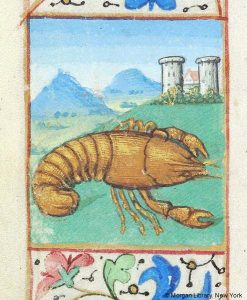
On June 21st we recognize Cancer, the astrological sign that Richard Hinckley Allen called the most “inconspicuous figure of the zodiac” (Allen, 107). Representing the sun at its highest point, Cancer is the zodiacal sign of the summer solstice. In ancient Egypt, the Cancer sign was imagined as a scarab beetle, and in Mesopotamia as a turtle or tortoise, both of which may have pushed the sun across the heavens. In Europe, traditionally, the constellation of Cancer was identified with the crab from Greek mythology that was crushed by the foot of Hercules and placed in the sky by Hera. Some have speculated that the characteristic sideways walk of hard-shelled crustaceans, whether crayfish or crab, could be symbolic of the backward shift in day-length after the arrival of the summer constellation in the Northern Hemisphere at the end of June, and Medieval people also believed those born under Cancer’s influence harnessed great, gripping power.
At the Index of Christian Art, the label “lobster-like” has been used to describe Cancerian crabs that are not at all “crab-like.” These crustaceans have elongated pincers, chunky claws, and a distinct tail, and they more closely resemble a lobster or a crayfish. The zoological treatise The Crustacea, published by Brill in 2004, states that, although crabs are the most frequent symbol of the Cancer sign, that the variety of shellfish that adorn horoscopes “can bring surprises” (Forest et al., 173). It is possible that while the symbol of Cancer may draw from a singular iconographic entity which included all shellfish, the idea of a distinct crab, including its spoken and written labels, could be historically transmutable. A definitive explanation for the choice of crustacean in horoscopes might be impossible, but there are some hints as to why “lobster-like” crabs were so pervasive in zodiacal art of the medieval period.
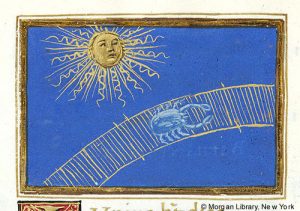
“Cancer,” “Crab,” & “Crayfish”
“Cancer” is an ancient word of Indo-European origin from a root meaning “to scratch.” Today Cancer is the scientific Latin genus name for “crab,” but in classical usage it described many species of shellfish. J.-Ö. Swahn notes in “The Cultural History of Crayfish” that in both Sanskrit and Greek the word for crab had the same meaning as crayfish, both animals having pincers. While the Latin word for Cancer, Carcinus, comes from the Greek karkinos, the English word “crab” has Germanic and Old English roots, and an Anglo-Saxon chronicle from about the year 1000 identified Cancer as crabba (Allen 107). In Old High German (800-1050), kerbiz meant simply “edible crustacean” and was also used to describe crayfish. The OED links the Middle High German (1050-1350) krebz to the Middle French (ca. 1400-1600) escrevisse, which in turn became écrevisse (crayfish).
The OED cites these words for crayfish, through much of their history, were general terms for all larger edible crustaceans. On “lobster,” OED notes some crayfish are called “fresh-water lobsters” and the term “lobster” is applied to several crustaceans of resemblance. Well into the seventeenth century, the word “cancer” and its translations were used as generic terms for all crabs and “lobster-like” creatures until Linnaeus established the species name Astacus Astacus for crayfish in his Systema Naturae of 1758 (interestingly, also with the synonym Cancer Astacus). The OED also noting that the 1656 translation of Comenius’ Latinae Linguae Janua Reserata, described the crayfish as a “shelled swimmer, with ten feet, and two claws: among which are huge Lobsters of three cubits; round Crabs; Craw-fish, little Lobsters.” So, etymologically speaking, crabs, crayfishes, and lobsters were mingled together from very early on.

Star Sign and Sustenance
In the Middle Ages, the zodiacal symbol of Cancer often appeared in the calendar pages of devotional books, or on adorned monumental sculpture of the Middle Ages. The Index records examples in these mediums (including examples on more than 200 manuscript pages) with the subject heading Zodiac Sign: Cancer. Generally, the depiction of the sign of Cancer as a crab is most prevalent in art from the Mediterranean and Western Europe, possibly due to the proximity to the sea, but the crayfish as a symbol for Cancer is not unusual, even in coastal regions. Crabs are saltwater decapods, creatures with ten feet or five pairs of legs. Crayfish are also decapods, but they thrive in freshwater lakes and rivers. Summer was the best season for fishing, and crayfish were easily trapped along the streams and creeks of rural Europe. The French and the English were the first to incorporate crayfish into their diet.
The Romans had viewed the crayfish as a scavenger animal, and they disliked the taste in their cuisine. Elevated from its lowly status as mere fodder in the classical era, crayfish came to be considered a delicacy in Western Europe from as early as the tenth century. In medicine, the sign ruled over the chest, stomach and ribs, and there are also several medieval pharmacological texts that note the medical properties of the crayfish, including the fact that “If you boil them in milk they cause a good sleep” (Swahn, “The Cultural History of Crayfish,” 247). We know that Europeans were using crayfish in their recipes and tinctures, so their distinctive form would have been a familiar one.
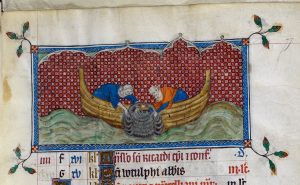
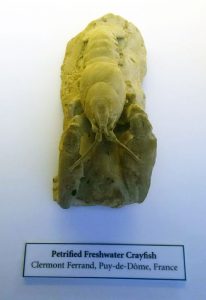
Sources
Allen, Richard Hinckley, Star-names and Their Meanings (New York, Leipzig: G.E. Stechert, 1899), 107-111.
Fischof, Iris, “The Twelve Signs,” in Written in the Stars: Art and Symbolism of the Zodiac (Jerusalem: Israel Museum, 2001), 111.
Forest, Jacques, J. C. von Vaupel Klein, and J. Chaigneau, The Crustacea: Treatise on zoology – anatomy, taxonomy, biology: Revised and updated from the Traité de zoologie (Leiden: Brill, 2004), 173.
Larkin, Deirdre, “Making Hay: The Zodiacal Sign of Cancer,” The Metropolitan Museum of Art Blog, June 5, 2009, http://blog.metmuseum.org/cloistersgardens/2009/06/05/making-hay/060509_bottom/
Swahn, J.-Ö, “The Cultural History of Crayfish,” Bulletin Français de la Pêche et de la Pisciculture 372-373 (2004): 243-251.
Oxford English Dictionary, s.v. “Cancer,” “Crab,” “Crayfish,” “Lobster,” accessed June 2016, http://www.oed.com/.
“Summer and Crayfish,” The Medieval Histories Blog, June 15, 2016, http://www.medievalhistories.com/summer-and-crayfish/.